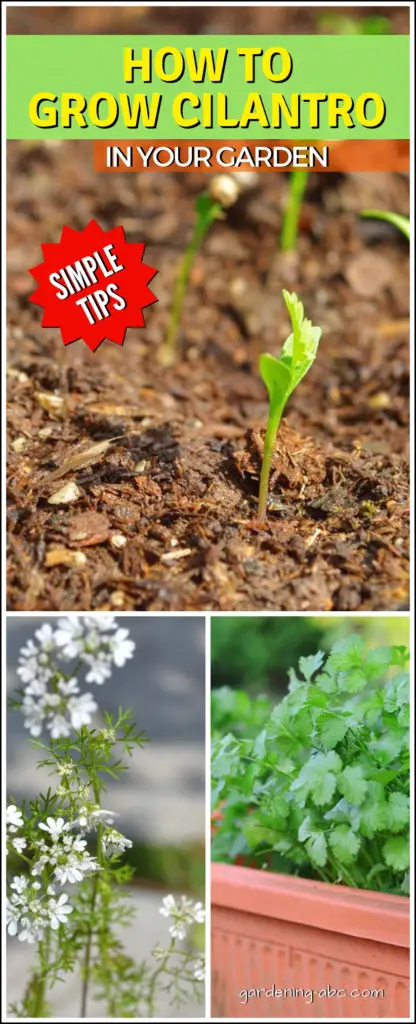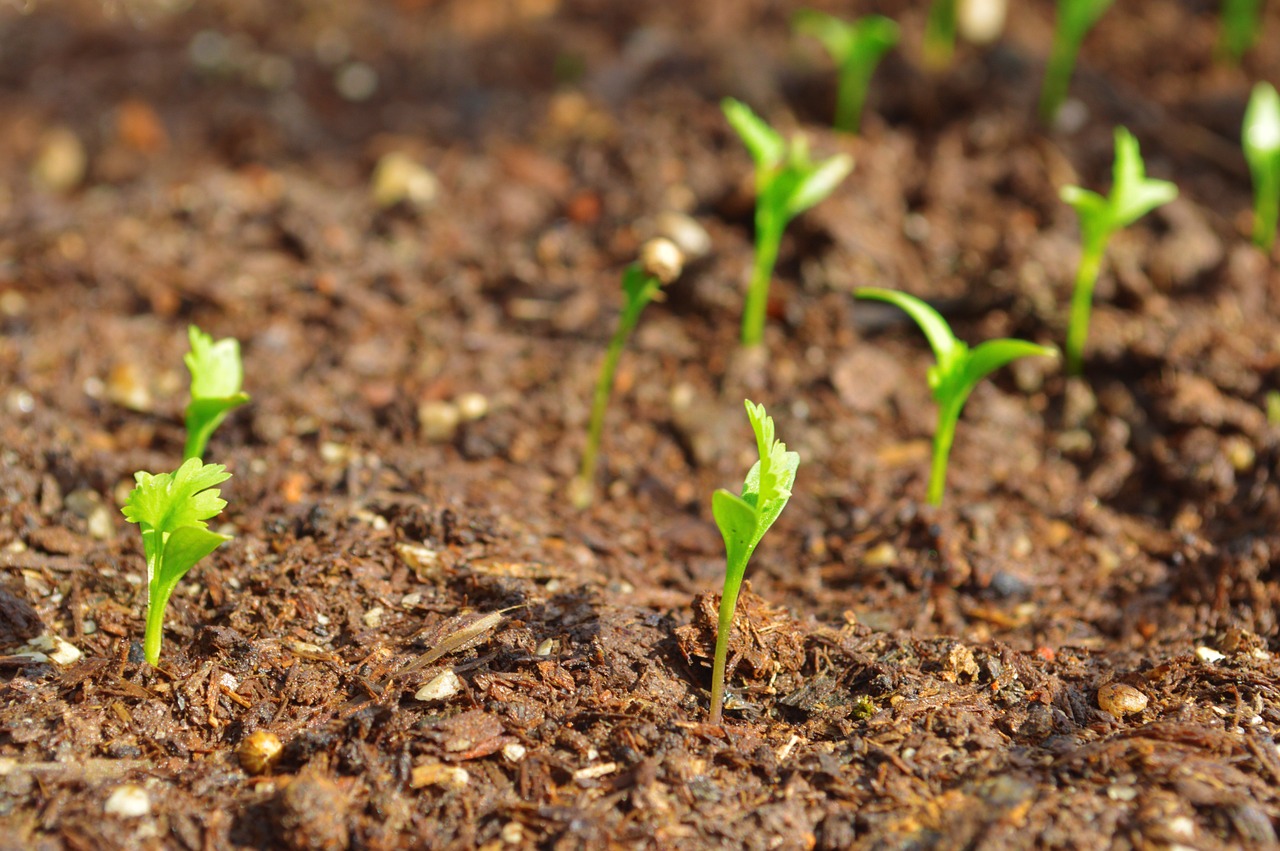We use affiliate links to run our site. When you buy through links on our site, we may earn an affiliate commission, without any added cost to you. Learn more
Cilantro is one of the easiest vegetables to grow especially if you are a beginner. You can grow cilantro in the garden as well as in the containers. I know many of us might still find it harder to grow cilantro in our garden. So, in this article, we will discuss how to grow cilantro and will share some useful cilantro growing tips.
Cilantro is also called Coriander in some countries. It has a pungent and slightly citrus taste to its leaves which adds to our taste buds. Most of us like the flavor of Cilantro leaves though I know some persons who find it very unpalatable.
The scientific name of cilantro is Coriandrum sativum.
From Seeds:
The easiest way to grow cilantro is from seeds. Sow the seeds indoors. The ideal temperature should be around 50-80 degrees F. It would take 2 weeks for the seeds to germinate.
The seeds that we are referring to here, are not actually “seeds” in technical terms, rather these are the fruits of the plant. You can either sow it as a whole or you can split them and sow it separately.
You can also use cuttings to propagate cilantro.
Transplantation:
The best way to grow cilantro is from the seeds. It generally does not go well with transplanting. If you still want to transplant the seedlings always use biodegradable pots to plant the seeds. It will minimize root disturbance when you transplant.
Seeds will germinate in 5-7 days. Once they have reached a height of 2 cm put the pot into the sun for further growth of the plant.
When To Plant Cilantro:
If you live in cooler conditions, the best time for planting cilantro would be in the early spring. That way you can harvest cilantro in summer till fall.
On the other hand, if you live in warmer areas, plant in the fall and harvest in the spring.
How to Plant Cilantro:
Sow the seeds 1⁄2 inch deep and give them a space of 2 inches between two seeds. This way it is easy for harvesting leaves.
If you want to harvest seeds then 8-10 inches of space is a minimum. The ideal gap between two rows should be at least 15 inches. You can also do successive plantings for a continued harvest.

Light:
Like most plants cilantro loves sunlight. So you should put them under direct sunlight. But you need to provide some cover from time to time otherwise the plant will bolt very quickly.
Growing Soil:
Cilantro prefers soil that is well-aerated, evenly moist, and light. If you want to use garden soil add sand and peat moss or coir to ensure good drainage.
The best option for growing cilantro would be to use a balanced well-aerated houseplant mix like this one. It drains quickly so you will never have to worry about overwatering your plants.
Temperature:
Cilantro is a cool-weather crop. The ideal temperature for growing cilantro is somewhere around 50 to 85 F. It can tolerate temperatures as low as 10 degrees F but if the temperature exceeds 85 F cilantro will start bolting.
Soil pH:
The ideal soil pH should be slightly acidic (6.2 to 6.8) for growing cilantro. Do a soil test with a pH testing tool like this. If the pH is on the higher side, reduce the pH with these methods. If the soil is too acidic use these methods to bring down the acidity level of the soil.
Location:
Cilantro prefers a sunny and dry location. Make sure your plants receive sunlight sometimes during the day. Use protective shade clothes to protect plants from too much sunlight.
Growing cilantro in containers:
Yes, cilantro grows well in any size pot and doesn’t mind being crowded together. Water only when the soil is dry, and use a general-purpose houseplant fertilizer to fertilize the plants.
Can You Grow Cilantro indoors:
Yes. You can definitely grow cilantro indoors. If you have a sunny window, keep the growing pot near the window. Just avoid placing it not too close so it doesn’t get overheated.
Water the plant when the soil is dry, and feed regularly.
Fertilizer:
Cilantro is a heavy feeder and needs some fertilizer, especially if you are growing them in containers. Use slow-release fertilizers to feed your plants. It helps to feed the plant throughout the growing season.
Fertilize your plants with a nitrogen-based fertilizer like this, once or twice during the growing season. Be careful of over-fertilization, too much nitrogen can make the leaves distasteful.
Water:
Although cilantro likes consistent moisture, too much water can be disastrous. It can cause root rot, fungal disease, and leaf drop. Moderate watering works best for cilantro.
Don’t allow the soil to dry out completely. Start watering the soil once the top couple of inches is no longer damp.
Make sure that the young plants don’t dry out. Once the plants get established they will need little water. Avoid overwatering as this plant does not do well in damp or humid conditions.
Learn more about watering a cilantro plant in this post.
Pruning:
Pruning is very important for cilantro as the larger leaves tend to be more bitter in flavor. You should prune often to encourage new leaf growth.
Prune using your thumb and forefinger. You can also use scissors or pruners to do the job.
Pest and Diseases:
Usually, cilantro is not very susceptible to pests and diseases due to its pungent smell. The problem only occurs if the soil remains very wet for a longer period. It can cause fungal problems as well as leaf spot diseases. You can keep these problems away by simply using well-drained soil for growing cilantro.
Some of the common pests of cilantro are:
- Leafhoppers
- aphids,
- mealy bugs,
- or spider mites on your plants.
Remove them manually with your hands or use organic pest control techniques to keep them away.
When to Harvest:
A fully grown coriander plant can grow up to 40 to 50 cm in height with a spread of 15 cm.
It generally takes 60-75 days before you can start harvesting leaves. For cilantro seeds, you may have to wait for at least 100 days. Here is how you can easily harvest both leaves and seeds from the plant.
Storing:
Use refrigerators to store cilantro leaves and stems. Place them in a thin layer in a resealable freezer bag or airtight freezer-safe container. Freeze cilantro and you can keep them for up to a year.
- If you are growing cilantro in a container, always use a bigger container like this so you can grow many plants in a single container.
- Though almost all the varieties will produce leaves and seeds, it is better to look for slow bolting varieties so you can enjoy the leaves for a longer period of time.
- In normal conditions, the germination rate of coriander is close to 50%. To increase the germination rate, soak in water for 3 days and then sow it into the soil.
- Put the seed into a healthy potting mix or well-drained soil. To make the soil ready you can add manure or compost to the soil.
Are you still buying cilantro from the market and getting disappointed with the look of them? Don’t waste your money anymore. Now the time has come to grow your own cilantro in your house. Growing cilantro will definitely add some exotic touch to your garden as well as to the dinner table.
Did you find anything helpful here? Don’t forget to PIN IT.

Amazon and the Amazon logo are trademarks of Amazon.com, Inc, or its affiliates.
